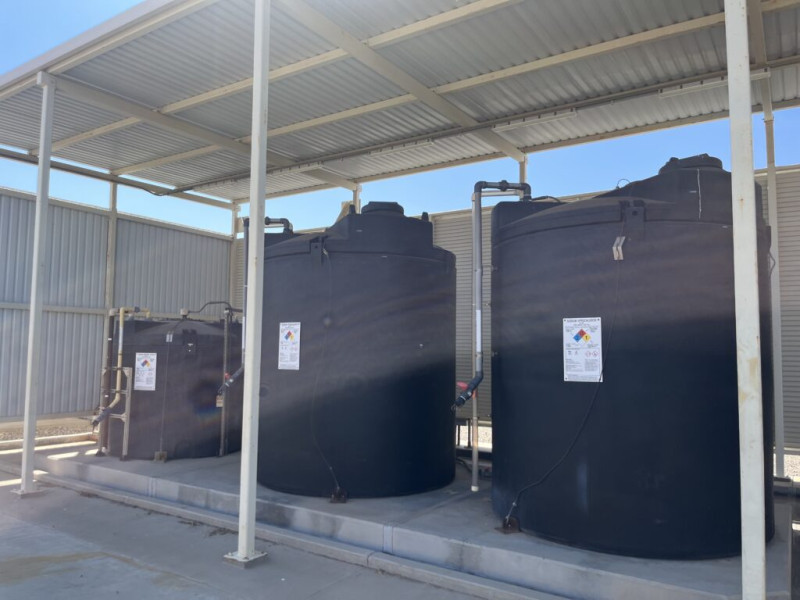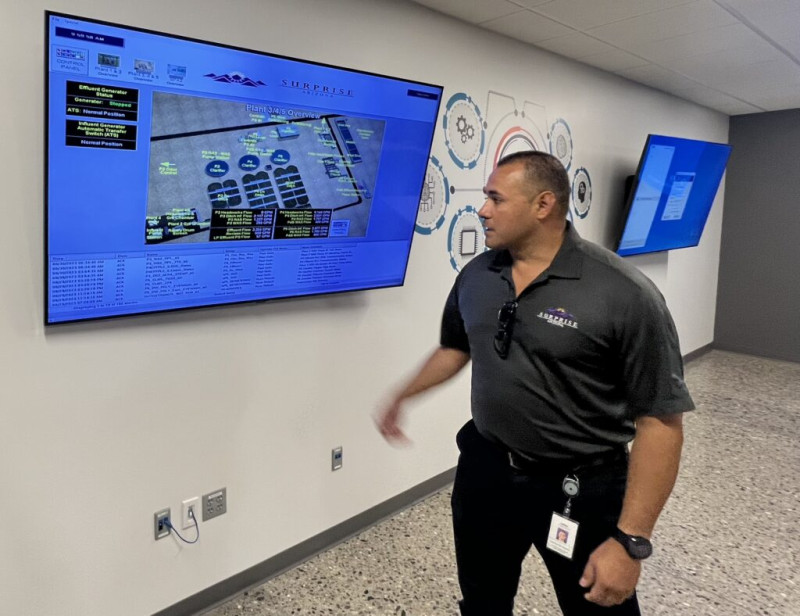As Drought Grips the Southwest, Water Utilities Find the Hunt For More Workers Challenging
Selwyn Sekaquaptewa has been on the hunt for talent for months.
As the general manager of the Hopi Utilities Corporation’s water service, he works with just two other staff members to provide clean and safe drinking water to the Hopi Tribe’s reservation in Northeast Arizona. When the corporation formed in 2017, five of the community’s wells did not meet federal arsenic standards, and it’s looking to expand its operations and upgrade existing infrastructure to continue improving the quality of the water on which the tribe relies.
But finding the workers to do that is proving difficult, and not just for Sekaquaptewa.
On the surface, it would seem Arizona is entering a golden age of water conservation. Gov. Katie Hobbs has made water conservation a top priority for her administration and promised to update the state’s groundwater rules as aquifers in the Phoenix metro area are projected to suffer shortages by the end of the century.
But finding the workers to design and implement new conservation measures, build new pipelines, monitor water quality, treat wastewater and repair infrastructure is proving almost as challenging as locating new sources of water. The issue is affecting nearly every water provider, from rural communities to major cities, as workers in the industry retire in droves and the industry struggles to replace them.
The importance of water access and maintaining infrastructure is rising across the country, as climate change and overconsumption diminish the flows on rivers and agriculture and development suck down the levels of aquifers throughout the U.S. That is perhaps most visible in Arizona, where communities are racing to determine how the region will keep up its rapid growth despite cutbacks of the supply of water from the Colorado River and shortages of groundwater. More so than ever, Arizona and the Southwest are looking to take big steps in water conservation and the construction of new pipelines and other infrastructure—as long as workers can be found.
“We have all this federal money and we have all this political energy to build new water supply projects,” said Michael Boule, the director of the Water Resource Management Department at Surprise, a city of about 150,000 residents in the Phoenix metro area’s West Valley. “But probably more constrained right now than us utilities in terms of employees are the design firms that are charged to design these improvements and the contractors that have to build these.”
In response, water providers are investing in partnerships with community colleges and establishing in-house training programs to bring in workers. But some experts worry Arizona’s lack of a regional approach to water issues will stifle the ability to build worker pipelines and create unified conservation programs that could enable cities to better cooperate on measures to deal with the diminishing supply of water, like advertising conservation measures, that could reduce the overall demand for water department staffing.
“If there’s no uniformity and no coordination, there’s no economies of scale,” said Gary Woodard, a water consultant and retired professor from the University of Arizona who has been working to find solutions to the labor issues in the field. “That’s frustrating.”
A Staffing “Train Wreck” in Arizona
Woodard’s first clue to Arizona’s water industry labor shortage was that he stopped having to look for work. For years, he worked for various water providers throughout the state as a consultant to model water demand and answer questions like where water was being used and how to reduce consumption. For years in Arizona, workers in the field played “musical chairs” as they bounced from one job to the next, he said, making it clear to him that the industry was struggling to recruit and retain talent.
But suddenly, cities began reaching out to him, and he had trouble keeping up.
“Now that you’ve got these drought contingency plans kicking in and the state investing $200 million in conservation, it just looked to me like this was going to go from a fairly serious staffing shortage to a train wreck,” Woodard said.
Boule, Surprise’s water department director, said any of his staff could take a call while leaving the office one day, and by the time they got in their car, they could have a new job with another water provider.


Surprise plans to double its water and wastewater workforce by the end of the decade to keep pace with the city’s growth. About a third of its current workforce of 75 people will be eligible to retire during that time, Boule said. The city will need to double down on its training programs to make up for the gap—and do its best to compete with other utilities for qualified staff.
“We have a bunch of new employees,” he said. “We have a bunch that are nearing the sunset of their career. And so there’s a huge effort to sort of download that institutional knowledge into these new employees.”
The labor issues aren’t just impacting traditional water utilities. Since 1990, the Central Arizona Project, a 336-mile-long system that delivers Colorado River water to around 80 percent of the state’s population, has had an apprenticeship program that trains students for five years with the goal of replacing 25 percent of its retiring craft and trade workers.
That’s helped CAP with retaining its institutional knowledge by connecting experienced employees with the next generation, said Frank Barbaro, the chair of the apprenticeship committee. But despite the program’s success, CAP is also seeing extended delays in hiring for positions. “Just like everybody else, it’s hard [to hire] because I think the numbers just within the trades themselves are diminishing,” he said.
New Partnerships Key to Growing Workforce
Across the state, water providers, both private and public, have dozens of job openings, even without including other trades with tasks and duties that can often overlap with water work. Without a regional or statewide effort to grow the industry’s supply of labor, water utilities are looking to do it themselves.
Even cities are getting involved. The Phoenix City Council recently approved new pay structures city-wide that the water department says will help it stay competitive in the hunt for new workers. Surprise’s economic development department is working on creating educational partnerships to help grow its local workforce.
“Usually it’s just about business attraction,” said Mike Hoover, the city’s assistant director for economic development, of the department. “Really what it’s now, is about supporting businesses and creating opportunities for our community members to have meaningful employment in and around their community.”
That shift has led to new partnerships.
A new career development fund from the city provides recent graduates of Surprise public or private schools, city residents or employees of businesses located there with full scholarships to attend a local community college for certain programs, including some relevant to the water department. The city is looking at potentially working with another local community college to create a cohort of students pursuing a water and wastewater operator certification.
Cities like Surprise and Phoenix are also hiring entry-level staff that they can train themselves to take positions that require certifications. “It’s hard for someone to come off the street and get into this field without a certification,” said Reynaldo Aldava Jr., Surprise’s wastewater manager who helps oversee the water department’s recruitment and education partnerships. “So the training position eliminates all those requirements.”
Even so, it will likely take years for the number of workers to catch up with the demand without more support from the regional or state level. But utilities plan to do everything they can themselves to turn that around, with a big focus for all being promoting an image of work in the water industry as an appealing and lucrative blue-collar job.
“Our mode right now has been taking the people within our organization that are truly passionate about water and passionate about working for the city of Phoenix and putting them out in the world to tell our story and to communicate why working in water is fabulous,” said Brandy Kelso, the assistant director of the Phoenix Water Services Department.
But until more people can be trained and certified to work in the industry, utilities will continue to compete with one another for applicants.
That’s something difficult for Sekaquaptewa, the general manager of the Hopi Utilities Corporation’s water utility.
He could potentially hire someone away from one of the smaller water systems on the reservation, but then that would leave them without someone to manage that system, and most of them are nearing retirement, anyway. He could hire someone living off the reservation, but then they wouldn’t have a place to live. “We’re so remote; we have a housing crisis,” Sekaquaptewa said. “We don’t have housing for them to live here.”
So Sekaquaptewa continues to call and meet with young people on the reservation who might have an interest in working in the water field. He tells them what all the utilities are telling local residents: “There’s a career here for you if you want it.”
Share this article
Disclaimer: The copyright of this article belongs to the original author. Reposting this article is solely for the purpose of information dissemination and does not constitute any investment advice. If there is any infringement, please contact us immediately. We will make corrections or deletions as necessary. Thank you.






